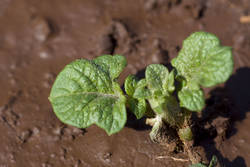Approach

- A young tomato plant growing on the land managed by the Maptheni Farmers' Association, Mpatheni, Swaziland
The project will build on the FAO Farmer Field Schools (FFS) experience gained in the higher potential areas of Kenya; an approach developed and tested as an extension-training and non-formal education tool for agricultural related topics (Sones et.al., 2003). The FFS approach will be modified to agro-pastoral systems by focusing on community-based land use and the testing of supportive methods. Innovative ideas will be taken up by cross-sectoral District and National Planning and decision-making processes which will ultimately influence policy change on SLM in agropastoral areas.
FFS is not an alternative to existing extension systems but rather certain principles of the FFS approach can be used to reach and empower marginalized farmers to alleviate poverty and reduce food insecurity.
Sectoral approach: Many projects have been sectoral in nature, with little coordination between actors at the national and district levels. Consequently, it is very difficult to assess complementarities, duplications or conflicts and so efforts and opportunities are lost and funds not optimized. Relevant ministries, departments, and development partners use different planning procedures with little room for change, or adoption of integrated planning procedures needed for sustainable land management.
This sectoral approach results in limited opportunity to share experiences among projects and programmes supported by different development partners. This affects the wider application of sustainable practices identified in the areas, and fails to address the broader causes of land degradation. By introducing a landscape/ecosystem approach through cross-sectoral planning mechanisms the proposed GEF interventions will support a more holistic planning cycle for SLM related activities and efforts.
Development of Agro-pastoral FFS
Despite the considerable FFS experience in Kenya, and several initiatives working on land degradation and related issues there are still many gaps that need to be filled, particularly related to adaptation of the approach for dryland and agro-pastoral areas. The FFS approach has previously not used cross-sectoral approaches and paid little attention to sustainability at the ‘landscape’ level. FFS activities prior to the PDF-B were not designed to halt desertification processes or conserve ecosystem integrity, but mainly aimed at increasing productivity. The introduction of FFS among agro-pastoral communities during the PDF-B phase has shown Agropastoral FFS to be an innovative method for extension services and implementation of SLM, a means to reach neglected communities, an important process for halting land degradation and desertification in the ASAL and a platform for agro-pastoralists to deal with a changing livelihood and resource base.
Main adaptations to the FFS approach developed and piloted at a very modest scale during the PDF-B phase (ICRAF/AHI 2008) include;
- Moving from individually owned and plot level land in FFS learning to a broader ‘landscape’ level, to include local watersheds, river-valleys, forested hill-tops, grazing lands, eroded gullies etc. on communal land.
- Combining work on private land, communal and trust lands where appropriate in order to address land issues holistically.
- Taking a multi-sectoral approach involving agriculture, livestock, forestry, water and environment sectors.
- Changing the reliance on GoK extension staff to focus more on the use of community-based/ farmer facilitators and innovators and integrate government investment in the priority landscapes.
- Focusing on the land/ crop/ livestock/ ecosystem interactions.
- Developing tools and methods appropriate for illiterate, semi-nomadic communities.
- Extending the lifespan of FFS to more than one season.
- Developing the FFS into a CBO, with capacity to manage communal land.
